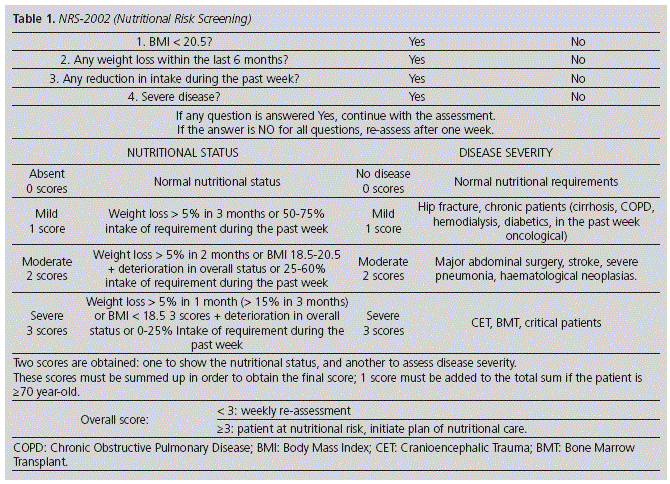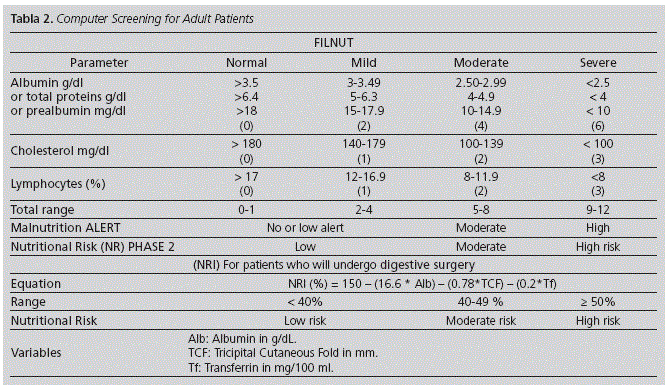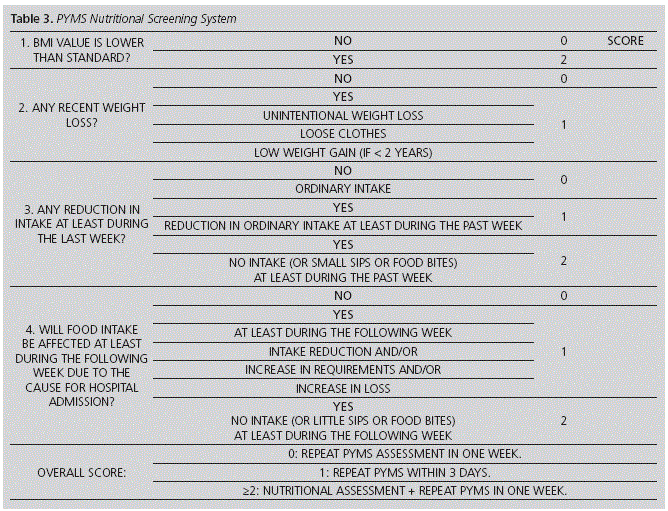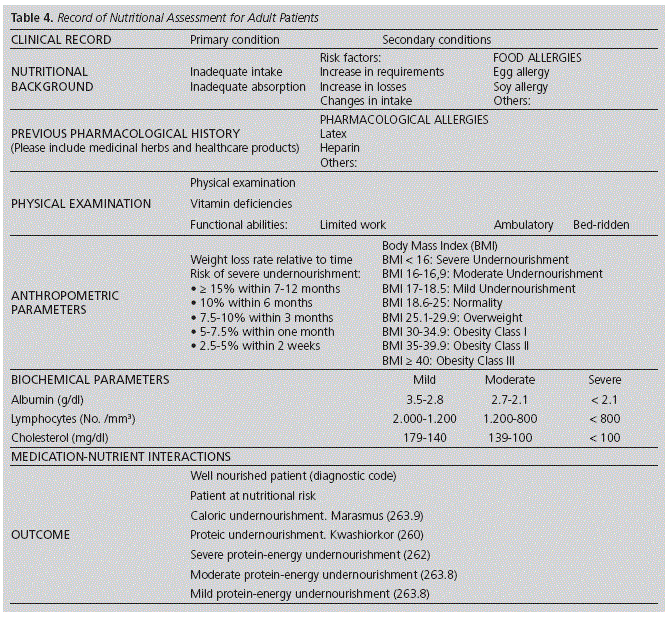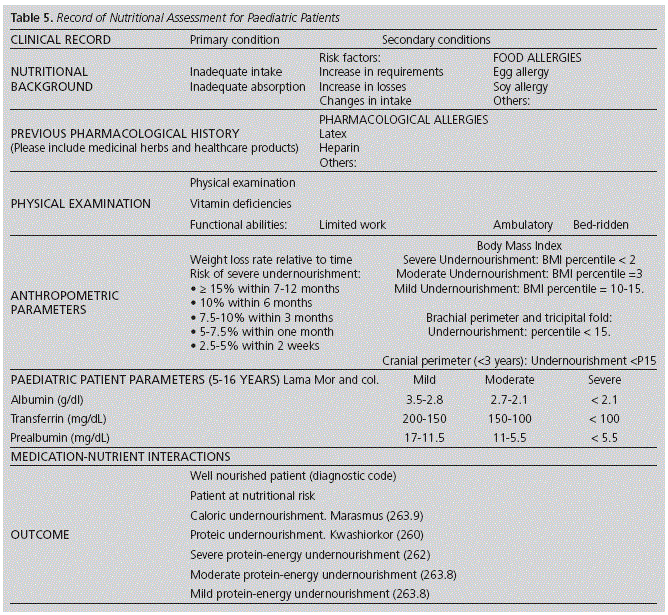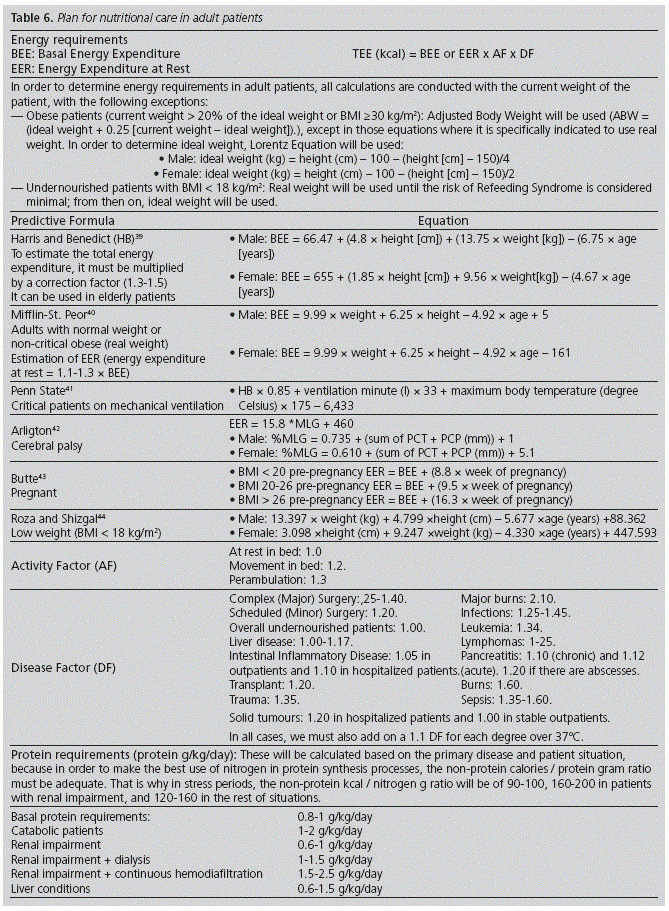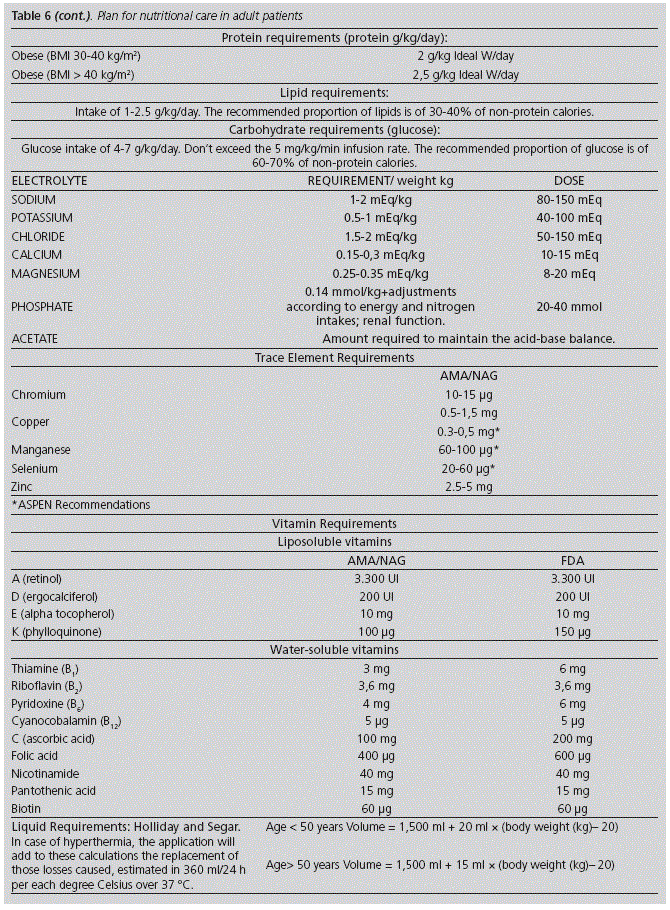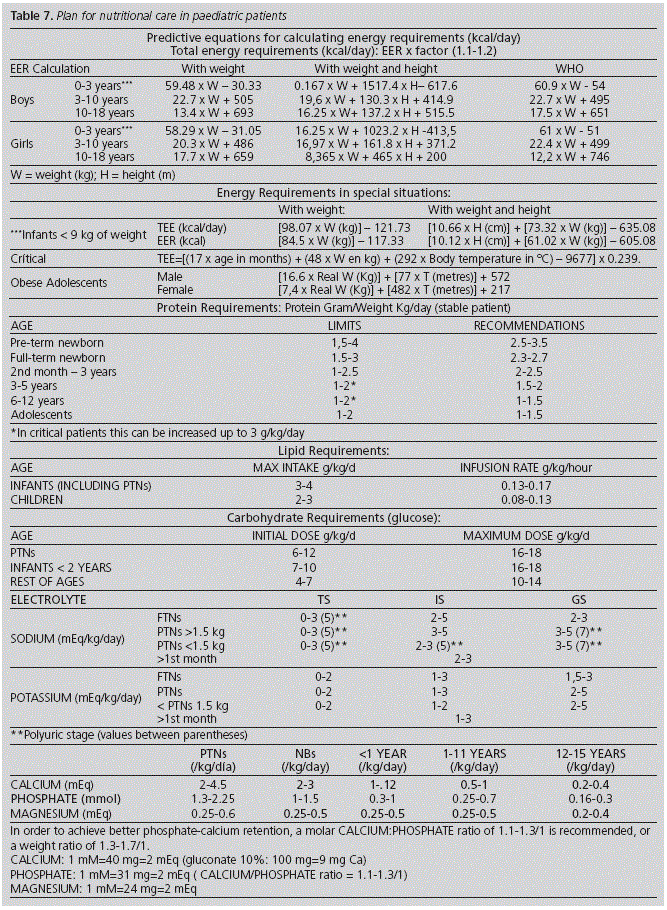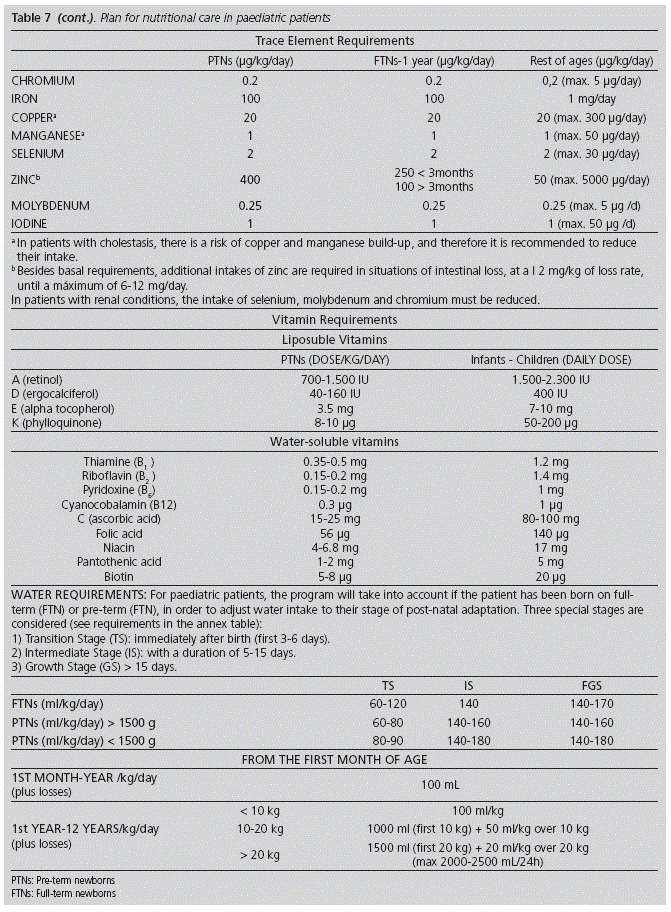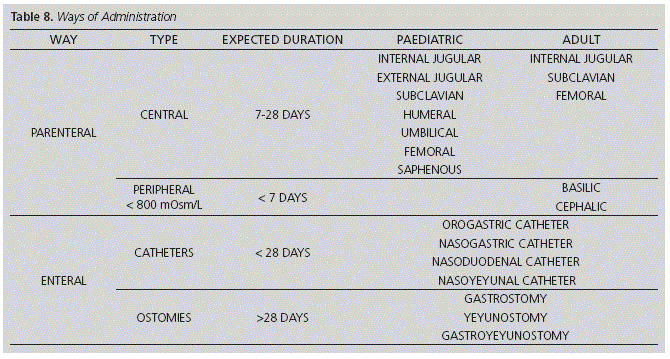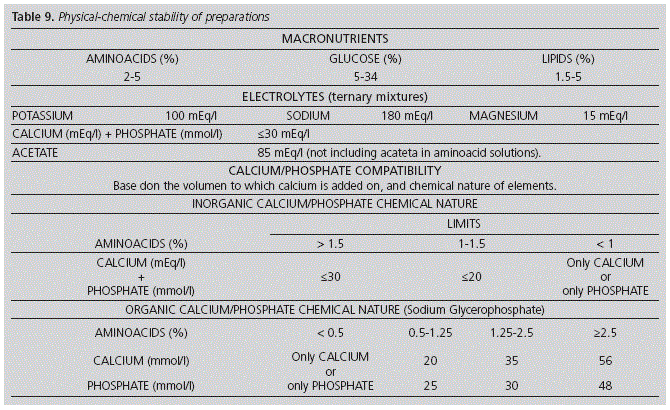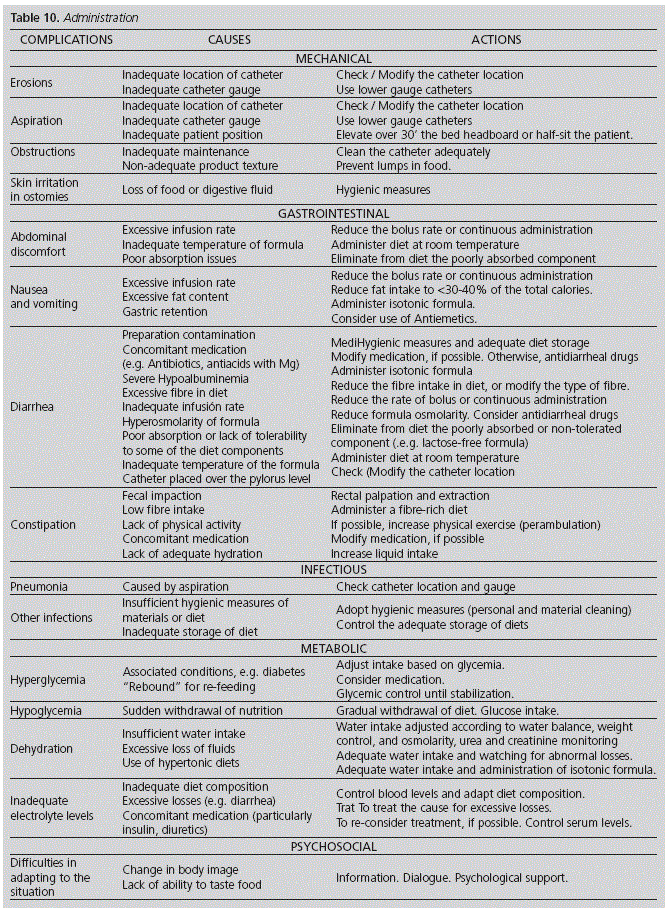Mi SciELO
Servicios Personalizados
Revista
Articulo
Indicadores
-
 Citado por SciELO
Citado por SciELO -
 Accesos
Accesos
Links relacionados
-
 Citado por Google
Citado por Google -
 Similares en
SciELO
Similares en
SciELO -
 Similares en Google
Similares en Google
Compartir
Farmacia Hospitalaria
versión On-line ISSN 2171-8695versión impresa ISSN 1130-6343
Farm Hosp. vol.39 no.5 Toledo sep./oct. 2015
https://dx.doi.org/10.7399/fh.2015.39.5.8807
ORIGINALES
Development of integrated support software for clinical nutrition
Desarrollo de una aplicación informática de ayuda al soporte nutricional especializado integrado en la historia clínica electrónica
Pedro Siquier Homar1, Manel Pinteño Blanco1, Miguel Ángel Calleja Hernández2, Francisco Fernández Cortés1 and Jesús Martínez Sotelo1
1Department of Pharmacy, Hospital Comarcal de Inca, Balearic Islands.
2Department of Pharmacy, Hospital Virgen de las Nieves, Granada. Spain
ABSTRACT
Objectives: to develop an integrated computer software application for specialized nutritional support, integrated in the electronic clinical record, which detects automatically and early those undernourished patients or at risk of developing undernourishment, determining points of opportunity for improvement and evaluation of the results.
Methods: the quality standards published by the Nutrition Work Group of the Spanish Society of Hospital Pharmacy (SEFH) and the recommendations by the Pharmacy Group of the Spanish Society of Parenteral and Enteral Nutrition (SENPE) have been taken into account. According to these quality standards, the nutritional support has to include the following healthcare stages or sub-processes: nutritional screening, nutritional assessment, plan for nutritional care, prescription, preparation and administration.
Results: this software allows to conduct, in an automated way, a specific nutritional assessment for those patients with nutritional risk, implementing, if necessary, a nutritional treatment plan, conducting follow-up and traceability of outcomes derived from the implementation of improvement actions, and quantifying to what extent our practice is close to the established standard.
Conclusions: this software allows to standardize the specialized nutritional support from a multidisciplinary point of view, introducing the concept of quality control per processes, and including patient as the main customer.
Key words: Computer system; Decision support; Nutritional assessment; Healthcare quality; Clinical nutrition.
RESUMEN
Objetivos: desarrollar una aplicacion informática integral en el soporte nutricional especializado, e integrado en la historia clínica electrónica, que detecte de forma automatizada y precoz a los pacientes desnutridos o en riesgo de desarrollar desnutrición, determinando puntos de oportunidad de mejora y evaluación de resultados.
Métodos: se han tenido en cuenta los estándares de calidad publicados por el grupo de trabajo de nutrición de la Sociedad Española de Farmacia Hospitalaria (SEFH) y las recomendaciones del grupo de farmacia de la Sociedad Española de Nutrición Parenteral y Enteral (SENPE). De acuerdo con dichos estándares de calidad, las etapas o subprocesos asistenciales que debe contemplar el soporte nutricional son: cribado nutricional, valoración nutricional, plan de cuidados nutricionales, formulación, elaboración y administración.
Resultados: la aplicación permite, de forma automatizada, realizar una valoración nutricional específica a los pacientes con riesgo nutricional, instaurando, si fuese preciso, un plan de tratamiento nutricional y realizando el seguimiento y trazabilidad de los resultados derivados de la implantación de acciones de mejora y, cuantificando en qué medida nuestra práctica se aproxima a la establecida como estándar.
Conclusiones: la aplicación permite estandarizar el soporte nutricional especializado desde un punto multidisciplinar, introduciendo el concepto de control de calidad por procesos y al paciente como cliente principal.
Palabras clave: Sistema informático; Soporte de decisión; Valoración nutricional; Calidad asistencial; Nutrición clínica.
Introduction
Malnutrition in the hospitalized patient is the result of the complex interaction between disease, diet and nutrition. It is important to understand the difference between malnutrition caused by undernourishment (uncomplicated starvation) or overnutrition (obesity), and malnutrition associated with a disease, because treatment success in the latter will require both nutritional and medical or surgical interventions, given that nutritional interventions alone cannot solve the metabolic anomalies associated with the disease or the injury1.
Malnutrition is associated with multiple factors. On one hand, the disease itself might lead to an inadequate intake of nutrients due to anorexia, difficulty to swallow, chewing problems, dysphagia, mucositis, or lack of autonomy for eating. This can also make digestion and food absorption difficult, and can even increase nutritional requirements, either due to metabolic stress or due to a higher or lower level of loss of nutrients. On the other hand, certain diagnostic or therapeutic procedures can also contribute to the development of undernourishment, either because fasting is indicated in order to conduct some explorations, because the patient is in the post-surgical period , or because digestive rest has been indicated as part of the treatment for specific phsyiopathological situations (pancreatitis, etc.)2-11.
A 23% of patients hospitalized in Spain are at risk of undernourishment; and this shows that undernourishment represents a safety problem for hospitalized patients, because it has impact on the complications of the disease which was the primary cause for hospitalization and those associated, it increases the risk of infections, it weakens the ability of responding to treatment, and reduces the level of immune response. All this will translate into an increase in costs and hospital stay. In Spain, this represents a mean 4-day increase in hospital stay, an increase of 1,409 € per patient, in those patients who were admitted with risk of suffering undernourishment, and of 6.000 € in those patients who suffered undernourishment during their hospital stay, compared with those who did not present undernourishment at any time12.
Specialized nutritional support is a high-complexity process which offers multiple opportunities for medication errors within its different stages: prescription, formulation, preparation, administration, or treatment monitoring13. Previous studies have estimated the percentage of problems associated with clinical nutrition between 30% and 60%14.
Parenteral Nutrition (PN) is included in the classification of high-risk medications, because it presents a high likelihood of causing severe damage to patients in case of inadequate use15. The United States Pharmacopeia (USP) has registered over 2,500 mistakes associated with PN within a 5-year period. More recently, 9 cases of deaths associated with the administration of PN contaminated by Serratia marcescens have been published16. Enteral Nutrition (EN) is not exempt from its own complications (mechanical, infectious, gastrointestinal and metabolic), and mistakes that affect patient safety. The USP and the ISMP have reported, within a 6-year period (from 2000 to 2006), 24 incidents associated with mistakes in the use of enteral nutrition; 33% of these were for sentinel events (permanent damage, potentially fatal situations, death)17.
We must not forget the current lack of awareness about this problem by healthcare professionals, because there is not enough training on nutrition matters, due to the lack of knowledge of the importance of malnutrition in patients' evolution, as well as to the lack of resources in order to adopt nutritional support systems.
All this leads to the lack of application of adequate measures of detection and control in patients with nutritional problems, an inadequate use of the existing nutritional support resources, an increase in morbimortality, and in the cost of patient care2-11.
Even though major methodological difficulties can appear in studies of nutritional intervention, there is evidence that nutritional intervention can improve the clinical evolution of the undernourished patient, and reduce those expenses associated with the disease18-20. The ruling by the Committee of Ministers of the European Council on diet and nutritional care in hospitals, approved on November, 12th, 2003, establishes the importance of malnutrition in hospitals, as well as the measures towards its prevention and treatment21.
Accordingly, and with the aim to maximize those resources available, it would be advisable to use support software which would allow to conduct an initial assessment towards the early detection of undernourished patients or those at risk of developing undernourishment, and subsequently, to conduct a more specific nutritional assessment, and to implement, if necessary, a nutritional treatment plan. Even though there are various computer programs available in our setting, which are associated with nutritional support (Nutridata©, Kabisoft©, Nutriwin©, Multicomp©, Medical One© 22,23, none of these gathers together all the recommendations for a comprehensive control of hospital undernourishment. For example, they don't feature a system of nutritional screening for adult and/or paediatric patients, and most of them don't allow to obtain the information required in order to conduct an adequate quality control at the time of obtaining the indicators of the different processes involved.
Objectives
1. To describe the characteristics of a new computer program for assisted electronic prescription of parenteral and enteral nutrition.
2. To define the different prescription assistances involved in the nutritional support process, with the aim to standardize nutritional support and include it in protocols.
3. To describe any entries conducted with the electronic clinical record of the Hospital Comarcal de Inca.
Methods
For the development of the computer software, the characteristics which all new technologies applied to medication use should include were taken into account, according to the recommendations by the Group for Assessment of New Technologies (TECNO Group) of the Spanish Society of Hospital Pharmacy (SEFH)24, as well as clinical practice standards published by the Work Group on Nutrition by the SEFH. According with said quality standards, the healthcare stages or processes that must be covered by the nutritional support system are: nutritional screening, nutritional assessment, nutritional care plan, prescription, preparation, administration, monitoring, and end of treatment13,25. The characteristics of each sub-process are described below, together with the different prescription assistances implemented.
The map of the healthcare process of the nutritional support in said software is initiated with the inclusion of patients through computer entry in the admission department. All patients will be screened within the first 48 hours since admission.
The nutritional screening selected for adult patients was NRS-2002 (26)or who are severely undernourished, or who have certain degrees of severity of disease in combination with certain degrees of undernutrition. Degrees of severity of disease and undernutrition were defined as absent, mild, moderate or severe from data sets in a selected number of randomized controlled trials (RCTs (Table 1) and FILNUT as computer screener27 (Table 2). For paediatric patients, the PYMS Nutritional Screening System was selected28 (Table 3). This section also includes an alternative method developed by the British Association for Parenteral and Enteral Nutrition (BAPEN), to determine patient size based on distance between olecranon and ulnar styloid process, and the age and gender of patients29.
If the adult patient has no nutritional risk, the application won't request the screening until after one week, as long as there is no FILNUT score of risk; and in paediatric patients, this will depend on the PYMS score (Table 3).
Adult patients with nutritional risk are assessed according with the Nutritional Assessment Registry (Table 4), and paediatric patients are assessed according to the recommendations by the Spanish Society of Paediatrics (AEPED) (Table 5)25,30.
If the patient is not undernourished, the program will classify him/her as a patient without nutritional risk.
The plan for nutritional care is defined for those patients who present undernourishment; said plan features an alarm system, which will inform if the limits of intake of different nutrients are exceeded (Table 6 and 7), and if the way of administration chosen is adequate, according with the estimated duration of the specialized nutritional support (Table 8). If during the estimation of requirements, the planned osmolarity for parenteral nutrition is superior to 800 mOsm/L, the software will indicate that the parenteral nutrition must be administered through a central line. In central lines, except for the umbilical for paediatric patients, the left or right side can be selected.
After determining the plan of care, the pharmacist must validate the prescription.
In the specific case of parenteral nutrition, according to the formulations for three-chamber, two-chamber and saline bags included in the program database, together with the stability conditions that any preparation must present (Table 9)31-33, the program will generate automatically the preparation which better adjusts to said conditions. If it was decided to modify said preparation due to clinical criteria, this can be confirmed again with the aim to determine its physical-chemical stability. If there is any physical-chemical incompatibility, the program will issue an alert through the relevant warning signals.
Once the preparation has been selected, the relevant preparation forms and labels are generated, with the "modus operandi" including: patient identification data, patient location (bed, hospital unit), date of preparation, volume of the different solutions that will allow to determine the order of addition into the bag, identification of products by lots, datamatrix codes to guarantee product identification and traceability, signature of the pharmacist in charge, signature of the staff in charge of preparation, preparation lot, and reference number.
Finally, the nursing staff will validate the administration by identifying patient and preparation through reading the bar codes (patient wristband) and datamatrix codes (nutrition) respectively; this will allow to determine that they are the right patient and the right preparation.
Besides, any complications that may arise during administration can be reported, by documenting their causes and any actions taken (Table 10).
For treatment monitoring, there is a section for collection of Vital Constants (systolic pressure, diastolic pressure, temperature, heart rate, partial oxygen saturation), fluid balance, and record of test results.
Regarding the end of treatment, the following options were determined as possible causes: hospital discharge, death, oral or enteral transition, loss of line, indisposition, worsening of the condition, or others. In this last case, there is a Notes section for specifying the cause that was the reason for ending treatment.
To obtain Quality Indicators, a module was selected for searching into the software database, in order to generate those indicators considered relevant, because it allows to relate all variables collected in sub-processes, as well as any prescription assistance implemented.
Outcomes
The computer program developed presents the following characteristics:
- It allows the nutritional screening of all patients, from hospital admission to discharge, with 24-hour monitoring 365 days of the year, with a series of screenings until hospital discharge.
- It incorporates automatic nutritional screening systems (FILNUT) (Table 2), and for interviews (NRS 2002 and PYMS) (Table 1, 3), that will increase the process efficiency.
- It incorporates the indirect method of height determination BAPEN, particularly interesting in bed-ridden patients.
- It allows the calculation of energy requirements based on metabolic stress and patient characteristics (cerebral palsy, pregnancy, low weight...) (Table 6, 7).
- It provides different prescription assistances based on patient evolution.
- It includes a traceability system of raw materials and sterile preparations, through a datamatrix coding system, as well as for patients through printed identifying wristbands.
- It allows a control of preparation stability according to the information included in the program database (Table 9).
- It prevents mistakes in parenteral nutrition preparation, by generating the preparation sheet with the correct order of component addition, thus preventing its instability.
- It documents the complications of the administration process, directing the nursing staff towards their possible causes, and offering actions to follow in order to correct them (Table 10).
- It prevents administration mistakes by allowing to print patient wristbands that will control the process through reading the datamatrix code of the sample and the barcode of the patient wristband.
- It incorporates a statistical module that allows to extract all information required in order to prepare the scorecard for a Nutrition Unit, according to published standards.
- It considers the multidisciplinary quality of processes, defining different accesses according to the profile of the user: physician, pharmacist, dietician, ward nurse, and pharmacy nurse.
- It generates discharge reports with the summary of all complications presented and the respective actions taken, together with the outcome of the specialized nutritional support.
- It allows an integration with the electronic clinical record (fluid balance and vital constants), hospital census and clinical test lab.
Regarding entries, in the specific case of the Hospital Comarcal de Inca, the set of standards for electronic information exchange HL7 version 2.5 are used. This is integrated with the clinical record of the centre: vital constants (systolic pressure, diastolic pressure, temperature, heart rate, partial oxygen saturation), clinical test unit (blood test and biochemical tests), and admission (hospitalization, transfer, and hospital discharge).
Discussion
The Institute of Medicine (IOM) puts forward the following as quality objectives in healthcare: patient safety, efficacy, orientation to patient, opportunity, and equity. These objectives correspond or are related, respectively, with the specialized nutritional support processes that have been incorporated in the program: nutritional screening, formulation of preparations, assessment of nutritional status, and plan for nutritional care, management and dispensing13.
There are different systems of automated nutritional screening systems for adult patients in scientific literature, CONUT and FILNUT, which allow the systematic detection and early identification of malnourished patients at hospital admission and during hospitalization. The FILNUT system has been implemented in the application developed, because by analyzing at patient admission the relationship between the nutritional risk detected by this screening method, mortality, hospital stay, and re-admission rate, it presented a 92.3% sensibility, a positive predictive value of 94.1%, a 91.2% specificity, and a 0.83 concordance (kappa index, estimated vs. a gold standard for nutritional assessment). Besides, it is worth highlighting that all those patients who meet the criteria for CONUT are included within FILNUT positives27,34.
According to the outcomes of our article, we must take into account that, in those cases where the integration with the hospital clinical test lab cannot be conducted, the FILNUT screening system will lose its benefit, if the outcomes of biochemical parameters must be entered manually. Therefore, in these cases the NRS-2002 interview system becomes more efficient. In those cases in which integrations with the admission unit and the clinical test lab are possible, the steps in the Method Section will be followed.
There are no automated screeners based on biochemical parameters in paediatric patients, because these are better markers for inflammation or infection than for undernourishment; therefore, they won't show the nutritional status of the patient in case of disease35. For this reason, paediatric patient screening is conducted through the PYMS interview system, which considers as malnutrition predictors: the body mass index, recent weight loss, reduction in intake during the past week, and any other condition or situation which might modify the nutritional status of the patient in the following week; these criteria are requirements for screening systems by the ESPEN guidelines28.
In order to determine the nutritional status of the patient, the SENPE-SEDOM Document on Hospital Undernourishment Coding has been adopted for adult patients. Said consensus has been adapted for paediatric patients in terms of biochemical and anthropometric parameters (36). Recently, the following classification for nutritional diagnosis in clinical practice has been proposed: undernourishment associated with starvation, when there is chronic starvation without inflammation; undernourishment associated with chronic disease, when there is chronic inflammation and with mild or moderate intensity, and undernourishment associated with acute disease or stress, when there is acute inflammation or severe intensity. This classification has not been taken into account, because the first version of the software was already under development; therefore, it will be taken into account for subsequent versions37.
According to the Institute for Safe Medicine Practices (ISMP), and as a key measure in order to reduce the risk of mistakes, the software will establish by protocol, through an alarm system, the range of maximum and minimal amounts of nutrients and additions for parenteral nutrition preparations, in order to guarantee their stability and compatibility; this will be the same as the majority of software programs currently marketed in our setting. This standardization will also affect clinical aspects, such as the limits in macronutrient contents or the calories/protein balance, which will facilitate treatment validation by the pharmacist, allowing them to confirm that the parenteral nutrition they are preparing is coherent and adapted to patient needs38.
Finally, it is worth highlighting that a closed module with the quality indicators published so that was not implemented, because said software allows to meet some of them per se, such as an universal screening of all hospital population, and nutritional diagnostic coding of patients.
So that the application can be more versatile, all information contained can be used through the generation of dynamic tables combining all variables of different sub-processes; for example, it is possible to determine the relationship between patients at nutritional risk and the level of undernourishment, the prevalence of undernourishment, the number of days on nutritional support based on level of undernourishment, etc.
All these data can be exported in excel, csv and pdf format, so that they can be treated with other information systems for subsequent treatment, if required.
Summing up, this software introduces the concept of quality control by processes in specialized nutritional support, with the objective to determine any points of likely improvement, as well as the assessment of its outcomes.
Once the software has been developed, it is necessary to set it into production, in order to determine if the standardization of specialized nutritional support with said tool will translate into an improvement in quality standards, and in order to assess its limitations.
![]() Correspondence:
Correspondence:
Correo electrónico: pedro.siquier@hcin.es
(Pedro Javier Siquier Homar).
Recibido el 6 de febrero de 2015
Aceptado el 13 de abril de 2015.
Bibliography
1. García de Lorenzo A, Álvarez Hernández J, Planas M, Burgos R, Araujo K. Consenso multidisciplinar sobre el abordaje de la desnutrición hospitalaria en España. Nutr Hosp. 2011;26(4):701-10. [ Links ]
2. Roubenoff R, Roubenoff RA, Preto J, Balke CW. Malnutrition among hospitalized patients. A problem of physician awareness. Arch Intern Med. 1987;147(8):1462-5. [ Links ]
3. Jebb SA. Incidence and recognition of malnutrition in hospital J. P. McWhirter and C. R. Pennington BMJ 1994; 308: 945-948. Clin Nutr. 1994;13(4):267-8. [ Links ]
4. Farré Rovira R, Frasquet Pons I, Ibor Pica JF. Postoperative complications in malnourished patients: economic impact and predictive value of some nutritional indicators. Nutr Hosp. 1998;13(5):233-9. [ Links ]
5. Fettes SB, Davidson HIM, Richardson RA, Pennington CR. Nutritional status of elective gastrointestinal surgery patients pre- and post-operatively. Clin Nutr. 2002;21(3):249-54. [ Links ]
6. Kondrup J, Johansen N, Plum LM, Bak L, Larsen IH, Martinsen A, et al. Incidence of nutritional risk and causes of inadequate nutritional care in hospitals. Clin Nutr. 2002;21(6):461-8. [ Links ]
7. Jeejeebhoy KN. Hospital malnutrition: Is a disease or lack of food? Clin Nutr. 2003;22(3):219-20. [ Links ]
8. Correia MITD, Waitzberg DL. The impact of malnutrition on morbidity, mortality, length of hospital stay and costs evaluated through a multivariate model analysis. Clin Nutr. 2003;22(3):235-9. [ Links ]
9. Reilly JJ, Hull SF, Albert N, Waller A, Bringardener S. Economic impact of malnutrition: a model system for hospitalized patients. JPEN J Parenter Enteral Nutr. 1988;12(4):371-6. [ Links ]
10. Bickford GR, Brugler LJ, Dolsen S, Vickery CE. Nutrition assessment outcomes: a strategy to improve health care. Clin Lab Manage Rev. 1999;13(6):357-64. [ Links ]
11. Pérez de la Cruz A, Lobo Támer G, Orduña Espinosa R, Mellado Pastor C, Aguayo de Hoyos E, Ruiz López MD. Malnutrition in hospitalized patients: prevalence and economic impact. Med Clin (Barc). 2004;123:201-6. [ Links ]
12. Alvarez-Hernández J, Planas Vila M, Leon-Sanz M, Garcia de Lorenzo A, Celaya-Pérez S, García-Lorda P, et al. Prevalence and costs of malnutrition in hospitalized patients: the PREDyCES study. Nutr Hosp. 2012;27(4):1049-59. [ Links ]
13. Sirvent M, Calvo MV, Sagales M, Rodríguez-Penin I, Cervera M, Piñerio G. Indicators monitoring the process of specialized nutritional support. Grupo de Nutrición de la SEFH. Farm Hosp. 2013;37(1):15-26. [ Links ]
14. Sevilla Sánchez D, Placeres Alsina MM, Miana Mena MT, López Suñé E, Codina Jané C, Ribas Sala J. Pharmaceutical intervention with parenteral nutrition. Farm Hosp. 2010;34(1):9-15. [ Links ]
15. ISMP-España. Recomendaciones para la prevención de errores de medicación. Boletín no27 (Internet). 2008 (cited 2015 Mar 12);24:9. Available from: http://www.ismp-espana.org/ficheros/Bolet%C3%ADn 27 Junio 2008.pdf. [ Links ]
16. Gupta N, Hocevar SN, Moulton-Meissner HA, Stevens KM, McIntyre MG, Jensen B, et al. Outbreak of Serratia marcescens bloodstream Infections in patients receiving parenteral nutrition prepared by a compounding pharmacy. Clin Infect Dis. 2014;59(1):1-8. [ Links ]
17. Guenter P, Hicks RW, Simmons D, Crowley J, Joseph S, Croteau R, et al. Enteral feeding misconnections: A consortium position statement. Jt Comm J Qual Patient Saf. 2008;34(5):285-92. [ Links ]
18. Isenring EA, Capra S, Bauer JD. Nutrition intervention is beneficial in oncology outpatients receiving radiotherapy to the gastrointestinal or head and neck area. Br J Cancer. 2004;91(3):447-52. [ Links ]
19. Naber THJ, Schermer T, De Bree A, Nusteling K, Eggink L, Kruimel JW, et al. Prevalence of malnutrition in nonsurgical hospitalized patients and its association with disease complications. Am J Clin Nutr. 1997;66(5):1232-9. [ Links ]
20. Eisenberg JM, Glick HA, Buzby GP, Kinosian B, Williford WO. Does perioperative total parenteral nutrition reduce medical care costs? JPEN J Parenter Enteral Nutr. 1993;17(3):201-9. [ Links ]
21. Committee of Miniters. Resolution ResAp (2003) 3 on food and nutritional care on hospitals. 2003 (Internet). 2003 (cited 2015 Mar 12). Available from: https://wcd.coe.int/wcd/ViewDoc.jsp?id=85747. [ Links ]
22. Martínez Olmos MA, Martínez Vázquez MJ, Montero Hernández M, Siquier Homar P, Valdueza Beneitez J, Morales Gorría MJ, et al. Evaluación de la actividad asistencial de un equipo multidisciplinario de soporte nutricional en el seguimiento de la nutrición parenteral total. Nutr Hosp. 2006;21(1):57-63. [ Links ]
23. Bermejo Vicedo T, Delgado Tellez de Cepeda L, Navarro Cano P, Vázquez Martínez C, Zamarrón Cuesta I, Morejon Bootello E, et al. Implementation of an assisted electronic prescription system applied to parenteral nutrition in a general hospital. Nutr Hosp. 2005;20(3):173-81. [ Links ]
24. Bermejo Vicedo T, Pérez Menéndez Conde C, Alvarez A, Codina C, Delgado O, Herranz A, et al. The application of new technologies to hospital pharmacy in Spain. Farm Hosp. 2007;31(1):17-22. [ Links ]
25. Calvo MV, Sirvent M, Caba I, Cervera M, García S, Gómez E, et al. Standardization of specialized nutritional support Nutrition Working Group (Spanish Society of Hospital Pharmacy). Farm Hosp. 2009;33(Suppl 1):3-107. [ Links ]
26. Kondrup J, Rasmussen HH, Hamberg O, Stanga Z. Nutritional risk screening (NRS 2002): a new method based on an analysis of controlled clinical trials. Clin Nutr. 2003;22(3):321-36. [ Links ]
27. Villalobos Gámez JL, García-Almeida JM, Guzmán de Damas JM, Rioja Vázquez R, Osorio Fernández D, Rodríguez-García LM, et al. INFORNUT process: validation of the filter phase-FILNUT--and comparison with other methods for the detection of early hospital hyponutrition. Nutr Hosp. 2006;21(4):491-504. [ Links ]
28. Gerasimidis K, Macleod I, Maclean A, Buchanan E, McGrogan P, Swinbank I, et al. Performance of the novel Paediatric Yorkhill Malnutrition Score (PYMS) in hospital practice. Clin Nutr. 2011;30(4):430-5. [ Links ]
29. Todorovic V, Russell C, Stratton R WJ and EM. A Guide to the "Malnutrition Universal Screening Tool" ("MUST") for Adults (Internet). MAG, editor. BAPEN; 2003 (cited 2015 Mar 13). p. 1-32. Available from: http://www.bapen.org.uk/pdfs/must/must_explan.pdf. [ Links ]
30. Asociación Española de Pediatría, Sociedad Española de Gastroenterología H y NP. Protocolos de Gastroenterología, Hepatología y Nutrición (Internet). 2o ed. Ergón S.A.; 2010 (cited 2015 Mar 13). Available from: http://www.aeped.es/documentos/protocolosgastroenterologia-hepatologia-y-nutricion. [ Links ]
31. University of Michigan. Hospitals and Health Centers. University of Michigan Hospitals & Health Centers Parenteral & Enteral Nutrition Manual. 9th ed. Btaiche IF, editor. 2010. [ Links ]
32. Mohler P, Banakar U. Issues in contemporary drug delivery. Part V: Total parenteral nutrition. J Pharm Technol. 1992;8:6-19. [ Links ]
33. Cardona D, Cervera M, Fernández M, Gomis P, Martínez M, Peñeiro G, et al. Consenso español sobre preparación de mezclas nutrientes parenterales. Farm Hosp. 2009;33(Supl 1):81-107. [ Links ]
34. De Ulíbarri Pérez JI, González-Madroño Giménez A, González Pérez P, Fernández G, Rodríguez Salvanés F, Mancha Alvarez-Estrada A, et al. New procedure for the early detection and control of hospital malnutrition. Nutr Hosp. 2002;17(4):179-88. [ Links ]
35. Lama More R a, Moráis López A, Herrero Álvarez M, Caraballo Chicano S, Galera Martínez R, López Ruzafa E, et al. Validation of a nutritional screening tool for hospitalized pediatric patients. Nutr Hosp. 2012;27(5):1429-36. [ Links ]
36. Alvarez J, Del Río J, Planas M, García Peris P, García de Lorenzo A, Calvo V, et al. SENPE-SEDOM document on coding of hospital hyponutrition. Nutr Hosp. 2008;23(6):536-40. [ Links ]
37. Jensen GL, Mirtallo J, Compher C, Dhaliwal R, Forbes A, Grijalba RF, et al. Adult starvation and disease-related malnutrition: A proposal for etiology-based diagnosis in the clinical practice setting from the International Consensus Guideline Committee. Clin Nutr. 2010;29(2):151-3. [ Links ]
38. Mirtallo J, Canada T, Johnson D, Kumpf V, Petersen C, Sacks G, et al. Safe practices for parenteral nutrition. JPEN J Parenter Enteral Nutr. 2004;28(6):S39-70. [ Links ]
39. Harris JA, Benedict FG. A Biometric Study of Human Basal Metabolism. Proc Natl Acad Sci U S A. 1918;4(12):370-3. [ Links ]
40. Mifflin MD, St Jeor ST, Hill LA, Scott BJ, Daugherty SA, Koh YO. A new predictive equation for resting energy expenditure in healthy individuals. Am J Clin Nutr. 1990;51(2):241-7. [ Links ]
41. Frankenfield D, Smith JS, Cooney RN. Validation of 2 approaches to predicting resting metabolic rate in critically ill patients. JPEN J Parenter Enteral Nutr. 2004;28(4):259-64. [ Links ]
42. Dickerson RN, Brown RO, Gervasio JG, Hak EB, Hak LJ, Williams JE. Measured energy expenditure of tube-fed patients with severe neurodevelopmental disabilities. J Am Coll Nutr. 1999;18(1):61-8. [ Links ]
43. Butte NF, Wong WW, Treuth MS, Ellis KJ, O'Brian Smith E. Energy requirements during pregnancy based on total energy expenditure and energy deposition. Am J Clin Nutr. 2004;79(6):1078-87. [ Links ]
44. Roza AM, Shizgal HM. The Harris Benedict equation reevaluated: Resting energy requirements and the body cell mass. Am J Clin Nutr. 1984;40(1):168-82. [ Links ]











 texto en
texto en 

